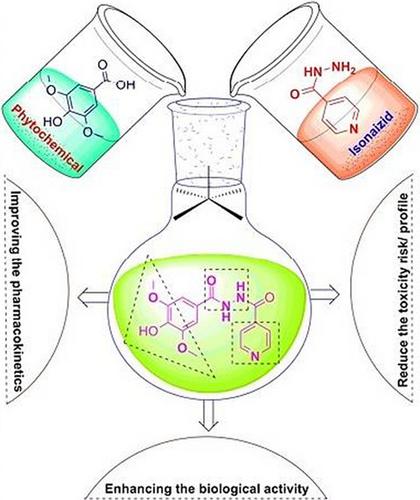当前位置:
X-MOL 学术
›
Chem. Bio. Drug Des.
›
论文详情
Our official English website, www.x-mol.net, welcomes your
feedback! (Note: you will need to create a separate account there.)
Isoniazid-phytochemical conjugation: A new approach for potent and less toxic anti-TB drug development.
Chemical Biology & Drug Design ( IF 3.2 ) Pub Date : 2020-03-31 , DOI: 10.1111/cbdd.13685 Shasank S Swain 1, 2 , Sudhir K Paidesetty 3 , Rabindra N Padhy 2 , Tahziba Hussain 1
Chemical Biology & Drug Design ( IF 3.2 ) Pub Date : 2020-03-31 , DOI: 10.1111/cbdd.13685 Shasank S Swain 1, 2 , Sudhir K Paidesetty 3 , Rabindra N Padhy 2 , Tahziba Hussain 1
Affiliation

|
Mycobacterium tuberculosis (Mtb) causes one of the most grievous pandemic infectious diseases, tuberculosis (TB), with long‐term morbidity and high mortality. The emergence of drug‐resistant Mtb strains, and the co‐infection with human immunodeficiency virus, challenges the current WHO‐TB stewardship programs. The first‐line anti‐TB drugs, isoniazid (INH) and rifampicin (RIF), have become extensively obsolete in TB control from chromosomal mutations during the last decades. However, based on clinical trial statistics, the production of well‐tolerated anti‐TB drug(s) is miserably low. Alternately, semi‐synthesis or structural modifications of first‐line obsolete antitubercular drugs remain as the versatile approach for getting some potential medicines. The use of any suitable phytochemicals with INH in a hybrid formulation could be an ideal approach for the development of potent anti‐TB drug(s). The primary objective of this review was to highlight and analyze available INH–phytochemical hybrid research works. The utilization of phytochemicals through chemical conjugation is a new trend toward the development of safer/non‐toxic anti‐TB drugs.
中文翻译:

异烟肼-植物化学共轭:一种有效且毒性较小的抗结核药物开发新方法。
结核分枝杆菌(Mtb)是最严重的大流行性传染病之一,即结核(TB),具有长期发病率和高死亡率。耐药性Mtb菌株的出现以及与人类免疫缺陷病毒的共同感染,对当前的WHO-TB管理计划构成了挑战。一线抗结核药物异烟肼(INH)和利福平(RIF)在过去的几十年中已因染色体突变而在结核病控制中广泛淘汰。但是,根据临床试验统计数据,耐受良好的抗结核药物的产量非常低。或者,一线陈旧的抗结核药物的半合成或结构修饰仍然是获得某些潜在药物的通用方法。在混合制剂中与INH一起使用任何合适的植物化学物质可能是开发有效的抗结核药物的理想方法。这篇综述的主要目的是突出和分析可用的INH-植物化学杂交研究工作。通过化学结合使用植物化学物质是开发更安全/无毒的抗结核药物的新趋势。
更新日期:2020-03-31
中文翻译:

异烟肼-植物化学共轭:一种有效且毒性较小的抗结核药物开发新方法。
结核分枝杆菌(Mtb)是最严重的大流行性传染病之一,即结核(TB),具有长期发病率和高死亡率。耐药性Mtb菌株的出现以及与人类免疫缺陷病毒的共同感染,对当前的WHO-TB管理计划构成了挑战。一线抗结核药物异烟肼(INH)和利福平(RIF)在过去的几十年中已因染色体突变而在结核病控制中广泛淘汰。但是,根据临床试验统计数据,耐受良好的抗结核药物的产量非常低。或者,一线陈旧的抗结核药物的半合成或结构修饰仍然是获得某些潜在药物的通用方法。在混合制剂中与INH一起使用任何合适的植物化学物质可能是开发有效的抗结核药物的理想方法。这篇综述的主要目的是突出和分析可用的INH-植物化学杂交研究工作。通过化学结合使用植物化学物质是开发更安全/无毒的抗结核药物的新趋势。











































 京公网安备 11010802027423号
京公网安备 11010802027423号